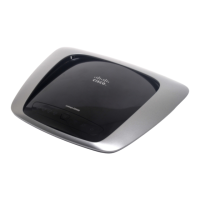23
Advanced Wireless-N Router
Linksys E2000 Chapter 3: Advanced Configuration
Channel Width If you are using the 2.4 GHz band, select
Auto if you want the Router to automatically determine
the proper channel width (20MHz or 40MHz) to use, or
select 20 MHz only (default) if you want the Router to
operate in Wireless-B and Wireless-G mode only. For best
performance, Auto is recommended.
If you are using the 5 GHz band, select Auto if you want
the Router to automatically determine the proper channel
width (20 MHz or 40 MHz) to use, select 20 MHz only
(default) if you want the Router to operate in Wireless-B
and Wireless-G mode only, or select 40 MHz only if you
want the Router to operate in Wireless-N mode only. For
best performance, Auto is recommended.
Channel Select a channel for your wireless network (from
1 to 11). If you are not sure which channel to select, then
keep the default, Auto.
SSID Broadcast When wireless clients survey the local
area for wireless networks to associate with, they will
detect the SSID broadcast by the Router. To broadcast the
Router’s SSID, keep the default, Enabled. If you do not
want to broadcast the Router’s SSID, then select Disabled.
Click Save Settings to apply your changes, or click Cancel
Changes to clear your changes.
Wi-Fi Protected Setup
There are three methods available. Use the method that
applies to the client device you are configuring.
Wireless > Basic Wireless Settings (Wi-Fi Protected Setup)
NOTE:
Wi-Fi Protected Setup configures one
client device at a time. Repeat the instructions for
each client device that supports Wi-Fi Protected
Setup
.
• Wi-Fi Protected Setup Button Use this method if
your client device has a Wi-Fi Protected Setup button.
a. Click or press the Wi-Fi Protected Setup button on
the client device.
b. Click the Wi-Fi Protected Setup button on the
Router’s Wi-Fi Protected Setup screen.
The Wi-Fi Protected Setup LED flashes blue for two
minutes during the Wi-Fi Protected Setup process
and lights up blue when the Wi-Fi- Protected Setup
process is successfully completed.
The LED lights up amber if there is an error during
the Wi-Fi Protected Setup process. Make sure the
client device supports Wi-Fi Protected Setup. Wait
until the LED is off, and then try again.
The LED flashes amber when a Wi-Fi Protected
Setup session is active, and a second session
begins. The Router supports one session at a time.
Wait until the LED is continuously lit or off before
starting the next Wi-Fi Protected Setup session.
c. After the client device has been configured,
click OK on the Router’s Wi-Fi Protected Setup
screen. Then refer back to your client device or its
documentation for further instructions.
• Enter Client Device PIN on Router
Use this method
if your client device has a Wi-Fi Protected Setup PIN
(Personal Identification Number).
a. Enter the PIN from the client device in the field on
the Router’s Wi-Fi Protected Setup screen.
b. Click the Register button on the Router’s Wi-Fi
Protected Setup screen.
c. After the client device has been configured,
click OK on the Router’s Wi-Fi Protected Setup
screen. Then refer back to your client device or its
documentation for further instructions.
• Enter Router PIN on Client Device Use this method
if your client device asks for the Router’s PIN.
a. On the client device, enter the PIN listed on the
Router’s Wi-Fi Protected Setup screen. (It is also
listed on the label on the bottom of the Router.)
b. After the client device has been configured,
click OK on the Router’s Wi-Fi Protected Setup
screen. Then refer back to your client device or its
documentation for further instructions.
The Network Name (SSID), Security, Passphrase and
Wireless Band are displayed at the bottom of the screen.
NOTE: If you have client devices that do not
support Wi-Fi Protected Setup, note the wireless
settings, and then manually configure those
client devices.

